 Features
Features

Chư Mom Ray National Park, Kon Tum Province in the Central Highlands of Việt Nam is home to a rehabilitation centre for many endangered species of monkeys and gibbons. The forest boasts many mysteries, waiting to be uncovered by scientists.
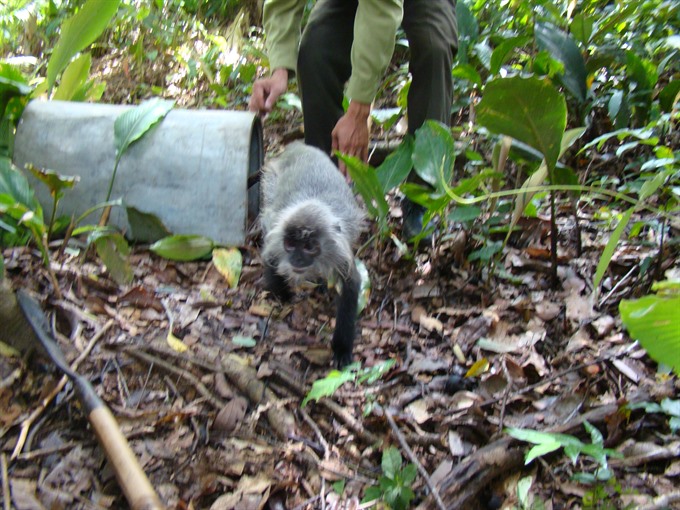 |
| Free again: A gibbon is released back to forest after its wounds have been treated in Chư Mom Ray National Park’s Centre for Rescue and Conservation. VNS Photo Phạm Anh |
Chư Mom Ray National Park, Kon Tum Province in the Central Highlands of Việt Nam is home to a rehabilitation centre for many endangered species of monkeys and gibbons. The forest boasts many mysteries, waiting to be uncovered by scientists.
by Phạm Anh
Wild animals are human, too.
Ironically, this is the feeling one gets on observing the gratitude and affection that creatures of the wild display for humans that have saved their lives and nurtured them back to health.
Ample instances of such “humanity” are on display at the Chư Mom Ray National Park, Kon Tum Province.
The Central Highlands park is home to a rehabilitation centre for many endangered species of monkeys and gibbons.
Most of the primates, which are listed in the Vietnamese and global Red Book of endangered species, have been found in critical condition. Once they are saved and healed, they return to the wild. Well, almost all of them. Some hang around.
“The strange thing about the forest is that it is a domesticated space for its inhabitants. Just like humans, monkeys also get ‘married’ when they grow up then live as separate families,” said Trần Quốc Tuấn, vice director of the park’s Centre for Rescue and Conservation.
“‘Native inhabitants’ is what we call the herds of monkeys living by the Khỉ (Monkey) Stream. Every noon, about 30 or 40 monkeys gather by the stream to bathe and play.
“At first glance, all the monkeys seem to belong to one troop, however after being ‘friends’ with them for years, we’ve learned that they are members of different troops, each of which includes between four to six members living together like a family. They also define their own borders, compete against each other for food and there is always one leader for each troop.”
Tuấn, 32, has spent nearly eight years in the shade of the national park. His passion for the forest and the injured primates that he and his colleagues have rescued and taken care of is obvious.
He took us to visit the area where the animals were recuperating after treatment. Reticulated pythons, iguanas, grey-shanked doucs: most were trapped, caught and transported illegally by poachers before being rescued.
On seeing us, one baby monkey jumped out from his cage. It made whimpering noises and clung to Tuấn like a baby. It had been taken care of by Tuấn and his colleagues for over a year. Though it has healed and its cage is always kept open, it has not returned to the forest, preferring to stay with its rescuers.
“When it was brought here, it was weak and needed special attention like a newborn. Its mother is said to have been killed in a trap. It needed to be fed with milk, carried in our arms and caressed. It is lucky to have survived until now,” Tuấn said.
 |
| Dangerous work: Forest wardens dismantle illegal traps in Chư Mom Ray Forest. On average, they collect thousands of illegal traps every year. VNS Photo Phạm Anh |
The monkey in a nearby cage tells another story. A member of a highly endangered species, it was found severely injured in a poacher’s trap. As an adult primate, it was very difficult to approach the animal for treatment, so it had to be anaesthetised first, and its wounds cleaned and sutured. After some time, the wounds healed but the monkey kept scratching the itchy pellicle, forcing Tuấn and his colleagues to apply antiseptic to the open wound and prevent it from scratching the place until it was totally healed.
Tuấn said this was one of thousands of cases that his centre has to deal with every year. They have been able to save most of the injured animals, but some are found in such bad condition that despite all the efforts taken at the centre, they don’t survive.
In one such case, a grown-up primate recently rescued from an illegal wildlife trader was so exhausted by the time it was brought to the centre that it refused to eat or drink water. It kept screaming painfully and scratching itself until it died.
“Monkeys are clever and cunning, but they are also full of affection, as we’ve seen that when we take care of them,” Tuấn said.
He told us about a gray-shanked douc that was brought from Tu Mơ Rông District to the centre. Everyone was moved to tears as it cried, refusing to leave its rescuer. It had been found in a field up a mountain, clinging to its dead mother, crying out weakly in hunger and thirst. It was taken home and raised like a small baby, surrounded by human affection, and had no desire to leave those who saved and nurtured it to health.
Forest mysteries
Đào Xuân Thủy, vice director of the Chư Mom Ray National Park, said young officials of its department of science and international cooperation have become “gibbon specialists”.
They can even remember the number of times the animals howl in the forest, he said.
We met some of the young staff the day we visited the park: Phạm Hồng Thái, Võ Hồng Tín and Nguyễn Thị Thúy Hằng, aged 26 to 30, were preparing for a one-week research and patrol trip.
“At first we listened to tape recordings of the howls. Over several field trips with researchers, we learnt how to find the animals’ shelter and to distinguish their distinct sounds,” Tín said.
While this sounds simple, it takes a lot of time and effort to cross streams and rivers in the forest to get near the monkeys’ shelters. They prefer to live in damp areas that human beings will find difficult to access.
Spending more time in the forest than even their own homes, the young staff are used to the habits of the primates. At five every morning in summer, the yellow-cheeked gibbons start to howl melodiously, waking up the whole forest. They are followed by a string of chants by other primates. Then the howls fade away, as the animals move about to find food.
“The longest distance that the sound of the gibbon can be heard is about 1.5km. It can be heard most clearly from about 400 or 500 metres away. However, it cannot be located with precision in a vast forest, so we still need to use the GPS (global positioning system). Then we divide ourselves into two groups and go separate ways for about one kilometre to listen,” Thái said.
“After nearly two years of surveying the Chư Mom Ray Forest, we estimate that there are about 20 to 30 rare species of gibbon,” Tín added.
Despite working in the forest for over 20 years, vice director Thủy has not yet visited every corner of the forest.
“It still conceals many mysteries that are waiting to be discovered,” he said.
The mysteries lie in the area between three mountains that face each other: the rear side of Chư Mom Ray Mountain, the south of Ngọc Tơ Num Mountain and the south of Nhọn Mountain. The area is very difficult for humans to access.
It is said that there is a tiger’s den on top of Nhọn Mountain, and in order to reach it, the Xê Đăng ethnic minority residents have to cross the “the garden of God”, about which the locals tell many mysterious stories.
Thủy believes that the longer scientists study the Chư Mom Ray National Park, the more hidden stories they will encounter. VNS
ASEAN Heritage
According to Deputy Director Đào Xuân Thủy, the Chư Mom Ray National Park, spanning the three districts of Sa Thầy, Ngọc Hồi and Ia Hdrai, was recognised as an ASEAN heritage site in 2004. With a total area of over 56,000 hectares, the park is home to over 1,500 species of flora and over 700 species of fauna, many of which have been designated threatened and listed in international and national Red Books. In 2010, three new species were found in the park: Cyrtodactylus pseudoquadrivirgatus (a new species of karst-dwelling bent-toed gecko), Amphiesma leucomystax (white-lipped keelback) and Opisthotropis cucae (Cuc’s Mountain Snake).
(The Vietnamese version of the story was published in the Thanh Niên newspaper on May 1, 2017)
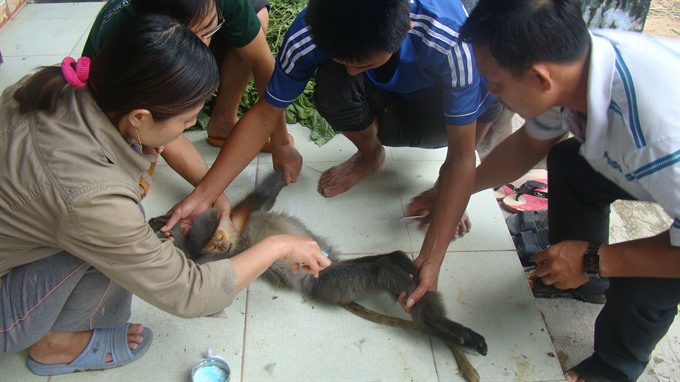 |
| Getting help: An injured gibbon is brought to Chư Mom Ray National Park’s Centre for Rescue and Conservation for treatment. VNS Photo Phạm Anh |
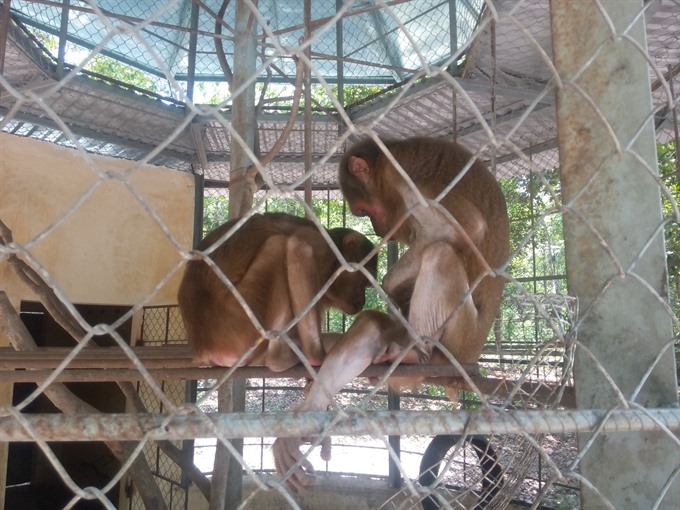 |
| Safe and sound: The monkeys are being treated in Chư Mom Ray National Park’s Centre for Rescue and Conservation. VNS Photo Phạm Anh |
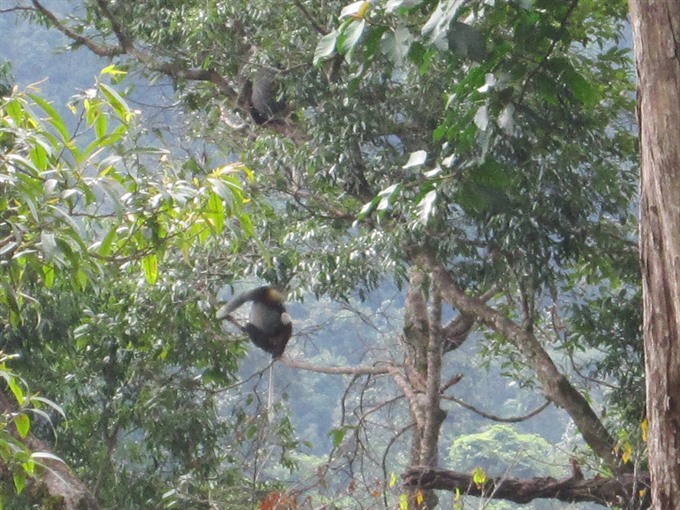 |
| Dense greenery: A troop of gibbons living in Chư Mom Ray Forest. VNS Photo Phạm Anh |
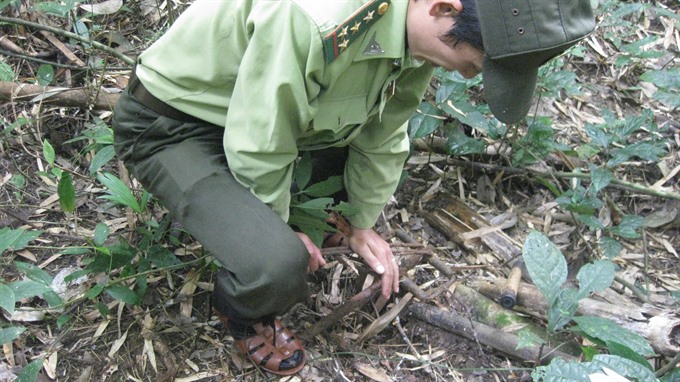 |
| Dedicated staff: A forest warden dismantles an illegal trap in Chư Mom Ray Forest. VNS Photo Phạm Anh |